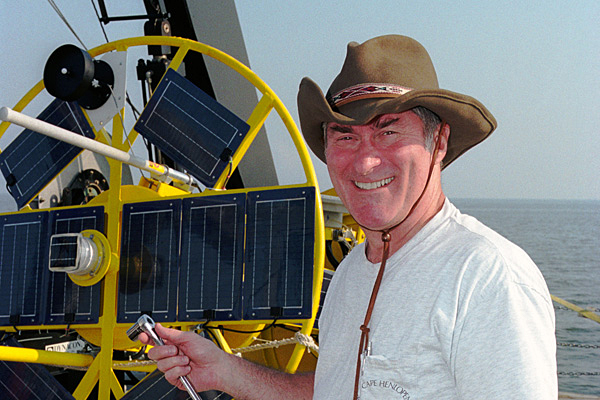
It's elemental
Paper in prestigious international journal celebrates discovery of iodine
11:16 a.m., Dec. 5, 2011--It's not every day that an element gets to celebrate a bicentennial, and a University of Delaware professor is pleased to have been invited to the "birthday party" for iodine, which was discovered in 1811.
George Luther, Maxwell P. and Mildred H. Harrington Professor at UD, is one of 11 internationally recognized co-authors on a paper commemorating 200 years of iodine research. The paper appeared on Friday, Dec. 2, in Angewandte Chemie, one of the prime chemistry journals in the world.
Research Stories
Chronic wounds
Prof. Heck's legacy
Most of us think of iodine as a liquid that comes in a little brown bottle to help heal cuts or as something that gets mixed in with table salt to prevent goiter. But the element that appears as number 53 in the periodic table was actually discovered during the Napoleonic Wars when French chemist Bernard Courtois was searching for an alternative to wood ashes as a feedstock for the production of saltpeter. Today, iodine has applications ranging from pharmaceuticals to semiconductors.
The element plays a role in a broad range of fields, including materials, medicine and physiology, atmospheric chemistry, geochemistry and marine chemistry. The latter is where Luther's expertise was called upon for the article. His section provides an overview of iodine and its major chemical forms in the marine environment.
"Iodine is incorporated into diatoms and other algae in the surface ocean," Luther says. "Upon death, some plankton sink to the sediments, and iodine is enriched in the sediments and their porewaters. There is also some release of gaseous iodine to the atmosphere from algal and plant sources. Weathering of the continents adds some iodine to the ocean via rivers to maintain the balance of about 0.45 micromolar total iodine that is in the ocean."
Apparently, Luther doesn't have to worry about running out of research opportunities any time soon. The authors conclude that in the ocean, the iodide–iodate transformation still offers challenges to biological and chemical oceanographers. At the same time, the biogenic, evolutionary origin of the high iodine levels encountered in marine sediments requires more research efforts.
However, the man who discovered iodine two centuries ago did not fare so well. Despite the scientific significance of his discovery and the growing commercial interest in iodine, Courtois did not capitalize on his discovery. He died in poverty on Sept. 27, 1838, at the age of 62. Iodine production from seaweed quickly became a major economic activity in the coastal regions of Europe, and others went on to benefit from his finding.
About the paper
“Commemorating Two Centuries of Iodine Research: An Interdisciplinary Overview of Current Research” appeared on Friday, Dec. 2, in Angewandte Chemie.
The paper was co-authored by Frithjof C. Küpper (Scottish Association for Marine Science), Martin C. Feiters (Radboud University Nijmegen, The Netherlands), Berit Olofsson (Stockholm University, Sweden), Tatsuo Kaiho (Kanto Natural Gas Development Co., Ltd., Japan), Shozo Yanagida (Center for Advanced Science and Innovation, Japan), Michael B. Zimmermann (ETH Zürich, Switzerland), Lucy J. Carpenter (University of York, UK), George W. Luther, III, (College of Earth, Ocean, and Environment, University of Delaware), Zunli Lu (Syracuse University), and Mats Jonsson and Lars Kloo (KTH Royal Institute of Technology, Sweden).
Article by Diane Kukich
Photo by Bob Bowden








